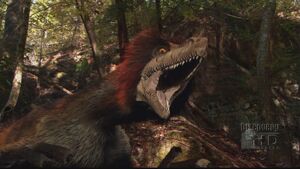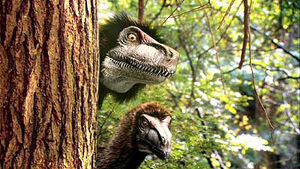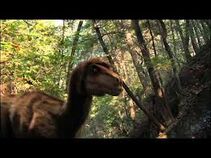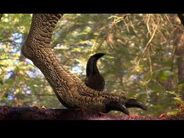
| |
| Creature information | |
| Scientific name : | Unspecified (formerly) |
| Time period : | Middle-Late Cretaceous |
| Primary diet : | Carnivore |
| In the documentary | |
| Fatalities caused : | Two Zuniceratops |
The Dromaeosaur was a group of small to medium-sized theropod dinosaurs. Size ranged from 70 cm to 7 m, It had a very stiff tail, like all dromaeosaurs, and is depicted as having a huge, sickle-shaped claw on its second toe, which was likely used by dromaeosaurs to restrain struggling prey.

Two raptors looking from behind a tree
In When Dinosaurs Roamed America[]
The dromaeosaurs are referred to as "raptors" in the Middle Cretaceous segment and are featured as the main dinosaurs. A pack of 3 are seen eating a dead Zuniceratops. A lone raptor arrives at the kill to feed, but the pack chases him away. The rogue raptor then runs into a Nothronychus and is wary, having never seen one before. The raptor sees it as potential prey and so attacks, but is promptly struck by the Nothronychus's claws back to the ground. Raptors rarely make mistakes, but Nothronychus is rare in America. The raptor then retreats, leaving the odd dinosaur to feed on the trees’ vegetation. Later, when the male Zuniceratops are fighting for dominance in the herd, the raptor pack hears the commotion and follow the sound, hoping to pick off the loser. Upon their arrival, the raptors simply bide their time and wait for a mistake to be made. Their patience is rewarded when the older bull Zuniceratops gets gored in the frill by the younger male. One of the raptors then attacks, using its toe claws to inflict deep slashes upon the wounded dinosaur’s flesh, but another Zuniceratops intervenes, driving the pack away. Later, just before a forest fire takes place, they finish off the old male. The fire overtakes much of the environment around them and cuts off the raptors’ path and they are subsequently burned alive, although some raptors did indeed flee and make it to safety along with some of the other dinosaurs.

Trivia[]
- These are the first feathered raptors, as well as one of the three first feathered dinosaurs, including the Coelurosaur and Nothronychus, ever to be featured in a dinosaur documentary. Prior to this, nearly all depictions of dromaeosaurs in the media showed them as scaly, almost lizard-like creatures, an appearance popularized by films such as Jurassic Park and its sequels, as well as even other previous documentaries such as Walking With Dinosaurs. Future documentaries such as Dinosaur Planet would go on to incorporate a feathered, much more bird-like design.
- It is a possibility these particular raptors could've been based on the dubious genus Richardoestesia, which was a maniraptoran Theropod thought to have lived throughout Cretaceous North America
- These raptors lived 20 million years ahead of the the Middle-Late Cretaceous segment.

Raptor's toe claw
Scientific Inaccuracies[]
- Dromaeosaurs, like all theropods, could not pivot their hands without breaking them; instead, their hands faced inward, in a “clapping” position.
- Dromeosaurs had more feathers in reality, including tail fans and wings; in life, they more than likely resembled large, flightless eagles or hawks with elongated tails and snouts, as well as teeth.
- Although these creatures are no longer considered “raptors”, it is worth noting that true dromaeosaurs are currently believed to have utilized their enlarged toe claws in holding down prey as they ate them alive, much like modern birds of prey, in a technique referred to as Raptor Prey Restraint, or RPR. For the longest time, it was believed that their claws were used to disembowel prey and inflict deep, fatal wounds, a belief perpetuated by this documentary and its respective raptors.
References[]
<references>

